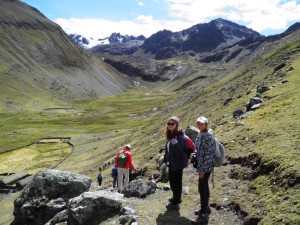After an hour bus ride and a fifteen minute hike into a steep u-shaped valley, we reached our first bofedale field site. This was a wetland environment was fed by groundwater recharge and a glacial runoff.
The first thing Denice and Edwin noted after getting to the field site was that the glacier had retreated drastically from where it was last year.

Benito, a 76 year old resident! of the bofedales, described to our translator Edwin how this wetland region changed in his lifetime. Benito recalled that when he was young the glaciers extended over all three of the nearby mountains and nearly reached his cabin.

Our fieldwork consisted of taking methane gas samples being emitted from the bofedales and taking measurements of pH, conductivity, discharge, and temperature in the nearby streams.

Here’s what some of the CAUSE students had to say about today’s adventure:
Izzy – “the view was phenomenal. We stood in the middle of a valley which overlooked what was left of the snow cap. We had to hike down and back up several times to the bus to get lunch and equipment. The hike was challenging for many but rewarding.several members of the group suffered from altitude sickness.”

Alyssa -“This was my first experience with fieldwork and I found it exciting that our work today will be ! part of advancing scientific research about how climate change affects ! Peru”

Lydia –
“The day was exhausting but so rewarding. We got a lot of good air samples from our methane chambers and water samples from the surrounding ravines, channels, streams, and still pools. I’m excited to see what results!”

Andrew (out of breath, panting) –
“Hiking up a mountain with a large suitcase of field equipment is hard”
